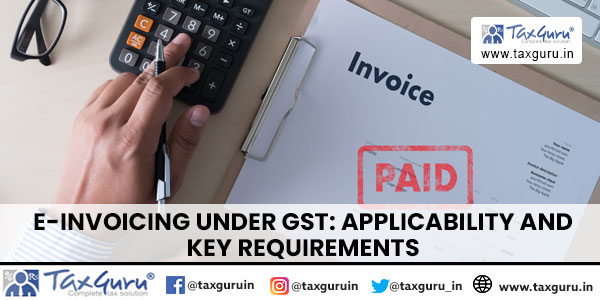E-Invoicing Under GST
The GST Council, during its 37th meeting on September 20, 2019, recommended the phased implementation of electronic invoicing (referred to as ‘e-invoicing’) within the GST framework.
E-Invoicing linkage from CGST Act 2017-
Section 31. Tax Invoice.-
(1) A registered person supplying taxable goods shall, before or at the time of,-
(a) removal of goods for supply to the recipient, where the supply involves movement of goods; or
(b) delivery of goods or making available thereof to the recipient, in any other case, issue a tax invoice showing the description, quantity and value of goods, the tax charged thereon and such other particulars as may be prescribed:

A taxpayer is required to mandatorily generate a tax invoice in accordance with the requirement of Section 31 of the CGST Act, 2017. The prescribed manner for issuing invoices is detailed in Rules 46 to Rule 55.
Rule 48-Manner of Issuing Invoice
(4) The invoice shall be prepared by such class of registered persons as may be notified by the Government, on the recommendations of the Council, by including such particulars contained in FORM GST INV-01 after obtaining an Invoice Reference Number by uploading information contained therein on the Common Goods and Services Tax Electronic Portal in such manner and subject to such conditions and restrictions as may be specified in the notification.
(5) Every invoice issued by a person to whom sub-rule (4) applies in any manner other than the manner specified in the said sub-rule shall not be treated as an invoice.
As per Rule 48(4), A specified class of registered persons are required to generate Invoice through GST Portal. Invoice generated through any means by those specified taxpayers are not recognized as valid invoice as per rule 48(5).
From the provisions of the above section and rule, the necessity for e-invoicing becomes evident.
Applicability of E-Invoice-
Applicability of E-Invoicing is based on the Aggregate Annual Turnover of the Taxpayer. Let’s understand the applicability of E-Invoicing from the below table-
| Sr. No. | Aggregate Annual Turnover | Effective Date of E-Invoicing Applicability |
| 1 | 500 Cr | 1st October 2020 |
| 2 | 100 Cr | 1st January 2021 |
| 3 | 50 Cr | 1st April 2021 |
| 4 | 20 Cr | 1st April 2021 |
| 5 | 10 Cr | 1st October 2022 |
| 6 | 5 Cr | 1st August 2023 |
Turnover should be reviewed for any prior financial year, from 2017-18 up to the current financial year
If the turnover for the any previous financial years is below the threshold limit but exceeds it in the current year, e-invoicing requirements will apply from the following financial year.
E-Invoicing would be applicable to following documents-
Tax invoice issued under Section 31 of CGST Act 2017.
Debit Notes issued under Section 34 of CGST Act 2017.
Credit Notes issued under Section 34 of CGST Act 2017.
E- Invoicing is not applicable on the following persons-
Banking and Insurance Sector
Goods Transport Agency
Passenger Transport Service Supplier
Admission to an exhibition of cinematograph films in Multiplex
SEZ Unit
E- Invoicing is not applicable on the following Supplies-
B2C Supplies
Nil-rated, non-taxable or exempt B2B Supplies
Nil-rated, non-taxable or exempt B2G Supplies
Imports
Time Limit to Generate E-Invoice-
Up to April 30, 2023, there was no time limit for generating an e-invoice. However, effective from May 1, 2023, taxpayers with an aggregate annual turnover exceeding ₹100 Cr are required to generate e-invoices within 7 days of issuing the tax invoice.
I would be waiting for the your comments. You can connect with me at caajay.dahiya@gmail.com or 8813817426.






If a registered vendor raised invoice 1-12-2024 , vendor submitted the invoice to client after 90 days .In this case what will happens and what kind of ITC issues will raise….Pls tell me.
If we have market aggregator, how to make gst impact and how to generate e invoice , also want to know that GST Number verification
This article really highlights the game-changing benefits of e-invoicing! As more companies adopt digital tools, it’s clear that e-invoicing not only speeds up payment cycles but also improves accuracy and reduces waste. Embracing this technology seems like a win-win for both companies and clients. Looking forward to seeing how it continues to evolve!